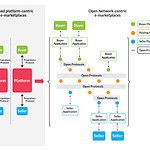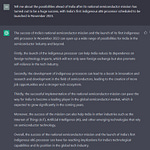Matsyanyaaya: Why Apple's teething troubles in India matter
— Shailesh Chitnis
Last year, between April and December, Apple exported more than $2.5bn worth of iPhones from India. Shipments during those eight months were nearly double the previous fiscal year’s (April 2021 - March 2022) total. For India’s “Make in India” ambitions, those numbers are promising.
They are also tiny. According to Bloomberg Intelligence, in 2021, India produced 3 million iPhones. China produced 230 million units during the same period. The sizable difference between the two countries should give decoupling champions some pause.
(Source: Financial Times)
India, or any other country, cannot hope to dislodge the Chinese manufacturing Goliath anytime soon. Apple has a long history in China, going back to 2007. Unwinding its dependence will take time.
The product is also highly complex to assemble. Indian contractors are learning this the hard way. Last month, the Financial Times reported that only half of all components produced at a Tata casing factory passed quality checks. The 50% yield compares poorly with Apple’s goal of zero defects.
Some of these teething troubles are to be expected. Private players such as Tata and Foxconn, Apple’s assembly partner, have strong incentives to fix the problems. But it highlights the difficulty of building a complex manufacturing base in India.
Building an iPhone requires an entire supply chain dedicated to moving components from one contractor to another quickly. In China, private contractors and the local government worked together to win Apple orders at all costs. India must show the same agility between the private and public sectors.
Apple had redesigned the iPhone’s screen at the last minute, forcing an assembly line overhaul. New screens began arriving at the plant near midnight. A foreman immediately roused 8,000 workers inside the company’s dormitories, according to the executive. Each employee was given a biscuit and a cup of tea, guided to a workstation, and within half an hour started a 12-hour shift fitting glass screens into beveled frames. Within 96 hours, the plant was producing over 10,000 iPhones a day.
From: Duhigg, (Charles & Bradsher, Keith) “How the U.S. Lost Out on iPhone Work”. The New York Times. 21 Jan 2012
Investing in skilled labour is another imperative. During Apple’s early years in China, the company sent its product designers and engineers to the manufacturing units, sometimes for months at a time. It invested in building custom machinery for some of those contractors. Apple’s level of involvement with China had a transformative effect on the country’s manufacturing and technical capabilities. It spawned an entire network of companies that serviced Apple and its suppliers.
The Indian government wants Apple to make a quarter of all its phones here by 2025. Getting there will require business and public services to scale up in ways they haven’t before.
Apple’s investment in India is critical for both the company and the central government. The company has signalled its intention to wean off its China dependency by publicly embracing alternatives. For India, this is a test of its commitment to move “up the stack” in manufacturing. Failure here will have far-reaching consequences that go beyond a single device manufacturer.
Antariksh Matters: What’s the matter with commercial space stations?
— Pranav R Satyanath
Last week, the United States National Aeronautics and Space Administration (NASA) released two new documents which outline expectations for new commercial space stations. The documents outline NASA’s operational and technical expectations from the new commercial space stations and add a new layer of nuance to NASA’s plan for transitioning from operating on the International Space Station (ISS) and conducting all Low Earth Orbit (LEO) operations on commercial space stations.
The ISS is the largest human-built structure in the Earth’s orbit. It is also a really old structure, with the first module of the ISS being launched in 1998. The ISS is also a testament to international cooperation in space, as it brought together Canada, Europe, Japan, Russia and the United States to collaborate on a massive space project. The ISS has stood strong despite all the difficulties thrown at it — from geopolitical tensions to space debris. But it needs a replacement, perhaps before the end of this decade.
To Bolding Go Commercial
The retirement of the ISS was initially slated for 2024, but the National Aeronautics and Space Administration (NASA) plans to extend its life through 2030. To replace the ISS, however, NASA has taken a bold route and decided to place all its bets on commercial entities. Although the US made Artemis its primary space policy goal, it still maintains an interest in LEO. Under the Commercial LEO Development (CLD) programme, NASA aims to commercialise LEO activities by opening the ISS for commercial activities and transitioning to research commercially-owned space stations by 2030.
Funding for new commercial space stations began in 2021 under the new CLD programme. NASA has funded three commercial entities to develop a private space station:
• Blue Origin (with Sierra Space) for the Orbital Reef space station: $130 million.
• Nanoracks (with Voyager Space Lockheed Martin) for the Starlab space station: $160 million.
• Northrop Grumman for a free-flyer space station: $125.6 million.
Further, NASA has also contracted Axiom Space for $140 million to develop and build a commercial module for the ISS over seven years.
These new commercial stations will be far smaller than the ISS. They will, perhaps, also cater to customers beyond national space agencies and cater to space tourists and high-paying nations that do not have their own astronaut programmes.
Getting Commercial Space Stations Going
So what are the challenges of getting commercial space stations up into space? First, it’s the funding. When the ISS first came into being, it had already cost a billion dollars in the 1980s to complete initial designs. Even today, the ISS consumes about a $ 3.1 billion dollars each year for operations and maintenance. Commercial space stations, meanwhile, will have to operate in a substantially together financial situation. A 2021 report by NASA’s Inspector General warned that the CLD programme vastly underestimates the costs of developing commercial space stations and that NASA has set itself the ambitious goal of transitioning to private space stations by 2028.
Second, if NASA goes through with the CLD programme without international partners, it risks losing the long-standing international collaboration that it has built with the Canadian Space Agency, and European Space Agency and has held since the 1970s. In February 2022, for example, the head of ESA’s Washington office, Sylvie Espinasse, said that the idea of purchasing commercial services from American companies in the future would not be an entirely acceptable option for European partners.
Finally, commercial space stations may not meet all of NASA’s space research requirements. The newly released documents, for example, highlight that the agency wants to conduct anywhere between 130-250 experiments each year. It also estimates to transfer of about 5000 km of cargo to commercial stations each year. Of course, NASA will likely be given priority on board the new space stations when they enter service. However, the agency might not have the same level of control or flexibility when operating in a station built by companies that also want to profit from activities such as tourism.
The commercial space station programme we know today may turn out very differently five years later. After all, commercial space is new territory for everyone, including NASA.
Cyberpolitik: First steps to better regulate military AI
— Atharwa Sarnobat
Artificial Intelligence, or AI, in recent days, has seen a resurgence of interest mainly due to the popularity of natural language AIs such as ChatGPT, which has captivated our imaginations with responses that simulate human conversations somewhat realistically. Similarly, governments around the world concerned with the use of AI in warfare convened for REAIM or the Summit on Responsible Artificial Intelligence in the Military Domain conference held at The Hague in the Netherlands. The joint conference was organised by the Netherlands and Korean governments and focused on the impact and regulation of AI in warfare.
The conference was out together with three specific aspects in mind:
Countries wanted to understand how AI played a role in warfare.
Countries wanted to get a clear picture of AI’s current and potential future impact in warfare.
Participants of the conference wanted to gain clarity on what the current legislative situation looked like and how that could be remedied by recommending newer legislation that could properly govern AI in warfare.
The conference highlighted a few ideas and brought them to the forefront of the discourse around AI in warfare, such as the fact that autonomous weapons systems were great from a tactical perspective since they put fewer humans in the line of fire and they could potentially even take the jobs of peacekeepers in the future. It was also understood that while much of the world did not want “killer robots” on the battlefield, a complete ban could not be achieved since the genie could not be put back in the bottle, and these weapons systems were here to stay.
The conference also recognised that the public discourse over the regulation of AI in warfare was severely lagging and that had to be remedied if effective laws governing its use were to be drafted and enacted by governments. It also noted that AI in warfare was a technological domain where nations were engaged in a technological arms race to maintain or achieve their superiority in the global context. A few areas of concern were identified regarding the regulation of AI in warfare. One central area of concern highlighted was the postulation that using AI in warfare would lower the threshold for using force in a conflict or armed engagement. Another was the idea that humans would be required to monitor AI weapons systems such as loitering munitions since these systems had not reached a stage where they could make those decisions by themselves.
Some participants recommended potential solutions, which proposed minimum acceptable levels for human control. The conference also recognised that old treaties on warfare needed to be updated to regulate military AI. Nations must also eliminate a high threshold approach to regulating military AI since these systems have broad use cases. Therefore, counties made the case that context-specific regulation was the only way forward.











Share this post